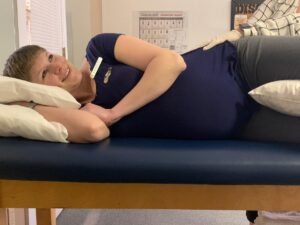
Pelvic floor physical therapy focuses on the examination and treatment of pelvic floor disorders, including issues related to urinary, bowel, and sexual health. This specialized area of physical therapy helps address the muscular, skeletal, and connective tissue imbalances or dysfunctions that affect the pelvic region. Here’s an overview of what this therapy entails in terms of examination and treatment:
1. Pelvic Floor Examination
The initial examination is key to understanding the pelvic floor concerns of the patient. The physical therapist typically follows these steps:
a. Patient History
- The physical therapist will gather information about the patient’s symptoms, including pain, incontinence, sexual dysfunction, or any other pelvic issues.
- Questions may also focus on the patient’s medical history, lifestyle habits, and daily activities, including posture, movement patterns, and any trauma or surgery to the pelvic area.
b. Observation and Posture Analysis
- The physical therapist observes the posture and alignment of the spine, pelvis, and lower body.
- Since poor posture or pelvic alignment can contribute to dysfunction, the physical therapist assesses how these issues may be affecting the pelvic floor.
c. Palpation
- The physical therapist may palpate the abdomen, hips, pelvic area, and lower back to check for muscle tension, tightness, or areas of tenderness.
- Palpitation can help assess the muscular tone of the pelvic floor muscles and identify any abnormalities.
d. Internal Examination (Optional)
- If the physical therapist has specialized training and if it’s appropriate for the patient’s symptoms, the physical therapist may perform an internal vaginal or rectal exam to assess pelvic floor muscle tone, strength, and coordination.
- Internal examinations can reveal any muscle tightness, weakness, or dysfunction such as pelvic floor muscle overactivity or underactivity.
e. Functional Movement Assessment
- The physical therapist will evaluate the patient’s movement patterns and strength through functional exercises, squatting, lifting, and other common activities.
- Dysfunctional movements may indicate underlying pelvic floor issues.

Pelvic floor physical therapy is beneficial during or following pregnancy.
2. Treatment for Pelvic Floor Conditions
Treatment involves a variety of approaches based on the patient’s specific needs. Some of the key treatment strategies include:
a. Pelvic Floor Muscle Training
- Kegel exercises: Often the first-line treatment for strengthening pelvic floor muscles, particularly in patients with urinary incontinence or prolapse.
- Biofeedback: A technique that uses sensors to give patients real-time feedback on their pelvic floor muscle activity, helping them improve control and function.
- Therapeutic Exercise: Focuses on strengthening, relaxing, and coordinating the pelvic floor muscles and surrounding areas to improve overall pelvic function.
b. Manual Therapy
- Soft Tissue Mobilization: Manual techniques to reduce muscle tension, trigger points, and fascial restrictions in the pelvic region.
- Joint Mobilizations: Focused on improving the movement and alignment of the pelvic joints, hips, and spine.
- Myofascial Release: A hands-on technique to release tension in the fascia, the connective tissue around muscles, which can alleviate pain and improve mobility.
c. Education and Lifestyle Modifications
- Bladder/Bowel Training: Techniques to help patients manage urinary and bowel issues through behavioral modifications.
- Postural Corrections: Advice on improving posture, movement mechanics, and ergonomics during daily activities to prevent further strain on the pelvic area.
- Dietary Modifications: In some cases, dietary changes may be recommended, particularly if the patient has constipation or pelvic floor dysfunction.
d. Pelvic Floor Relaxation Techniques
- For patients with pelvic floor tension or overactivity (pelvic pain, painful intercourse), relaxation strategies are emphasized, such as diaphragmatic breathing, mindfulness, and other relaxation exercises.

Pelvic floor physical therapy enables men and women to return to their favorite activities.
e. Electrical Stimulation
- Electrical stimulation may be used to stimulate the pelvic floor muscles to improve strength and coordination, particularly in cases of muscle weakness or incontinence.
f. Behavioral Techniques
- Cognitive-Behavioral Therapy (CBT): May be integrated when there are psychological factors contributing to pelvic health issues, such as stress, anxiety, or trauma-related pelvic pain.
- Bladder Retraining Programs: Instructing the patient on how to gradually increase the time between bathroom visits to improve bladder control.
g. Use of Devices
- Vaginal or Rectal Weights: These are used to strengthen the pelvic floor muscles by having the patient perform exercises while the weight is in place.
- Pessaries: Patient education regarding function and use of pessaries.
3. Conditions Treated in Pelvic Health Physical Therapy
Pelvic floor physical therapists treat a wide range of conditions, including but not limited to:

Pelvic floor treatment allows patients to get back to the lives they love.
- Urinary Incontinence (Stress, Urge, Mixed Incontinence)
- Pelvic Organ Prolapse
- Chronic Pelvic Pain
- Dyspareunia (Painful Intercourse)
- Painful Bladder Syndrome
- Endometriosis
- Fecal Incontinence
- Constipation
- Postpartum Rehabilitation
- Pregnancy-Related Pelvic Pain
- Pelvic Floor Dysfunction
- Painful Bladder Syndrome
- Sexual Dysfunction
Pelvic floor physical therapy is a specialized form of treatment that addresses a variety of conditions related to the pelvic floor. Through a detailed examination and personalized treatment plan, this treatment option can significantly improve the quality of life for patients dealing with pelvic health issues. Whether strengthening weakened muscles, relaxing overactive ones, or addressing alignment and posture, pelvic floor physical therapy aims to provide relief and restore function.

Dr. Brenda Murphy treats pelvic floor dysfunction at our Clifton Street clinic.
Rehab Associates offers pelvic health therapy for women and men at our Clifton Street practice. Call for an appointment today at 855-722-8478. For more information about Rehab Associates and pelvic health therapy, please follow this link: https://racva.com/womens-health/
